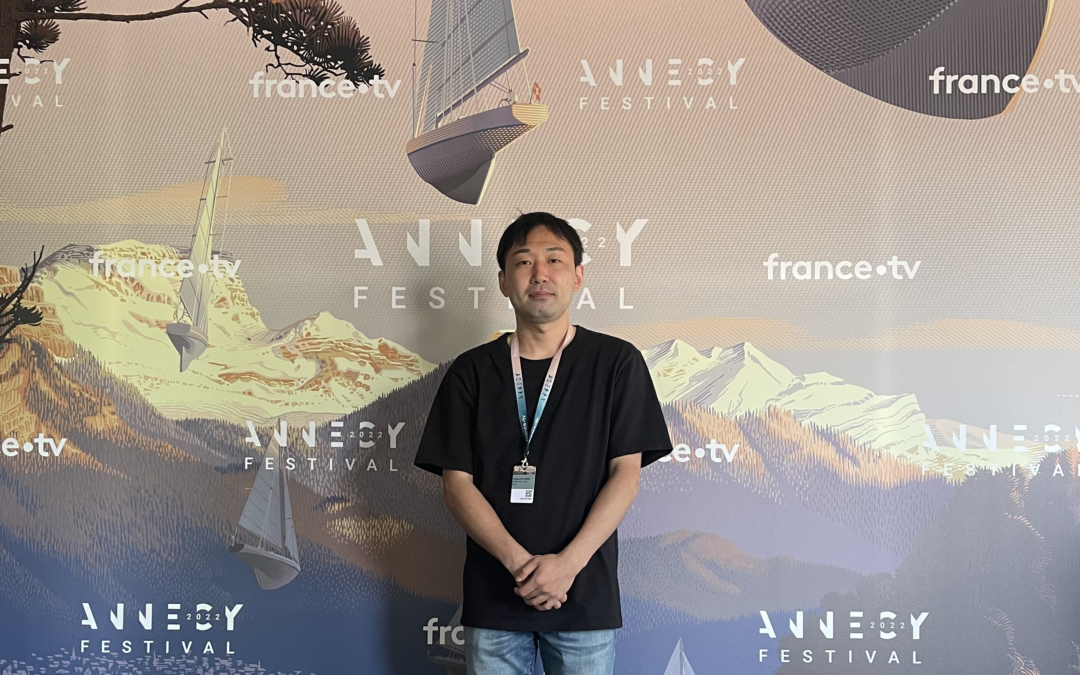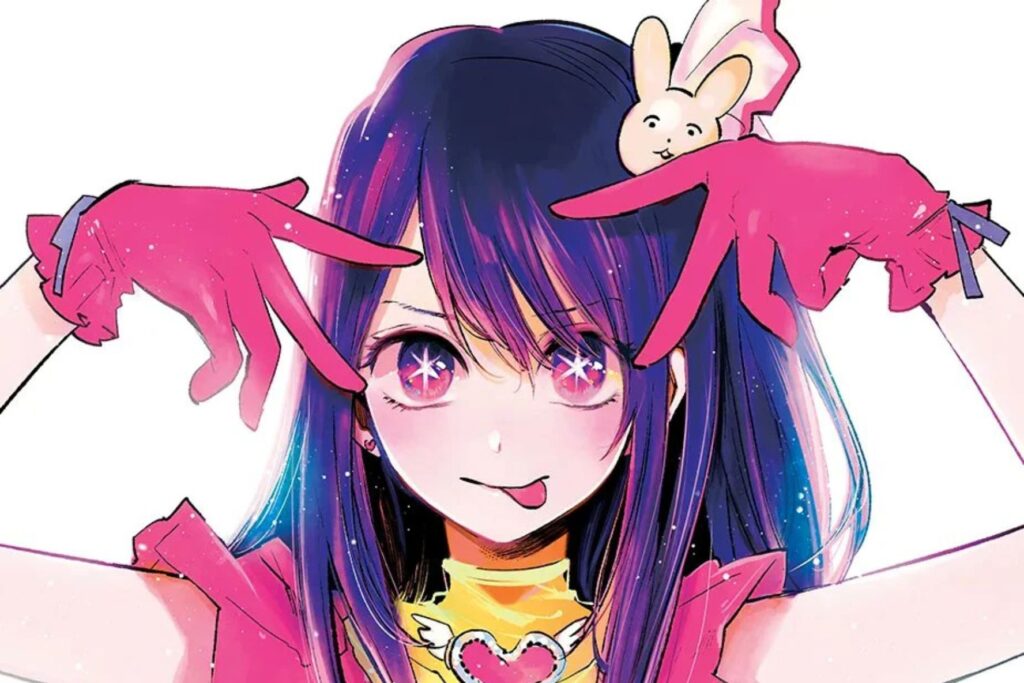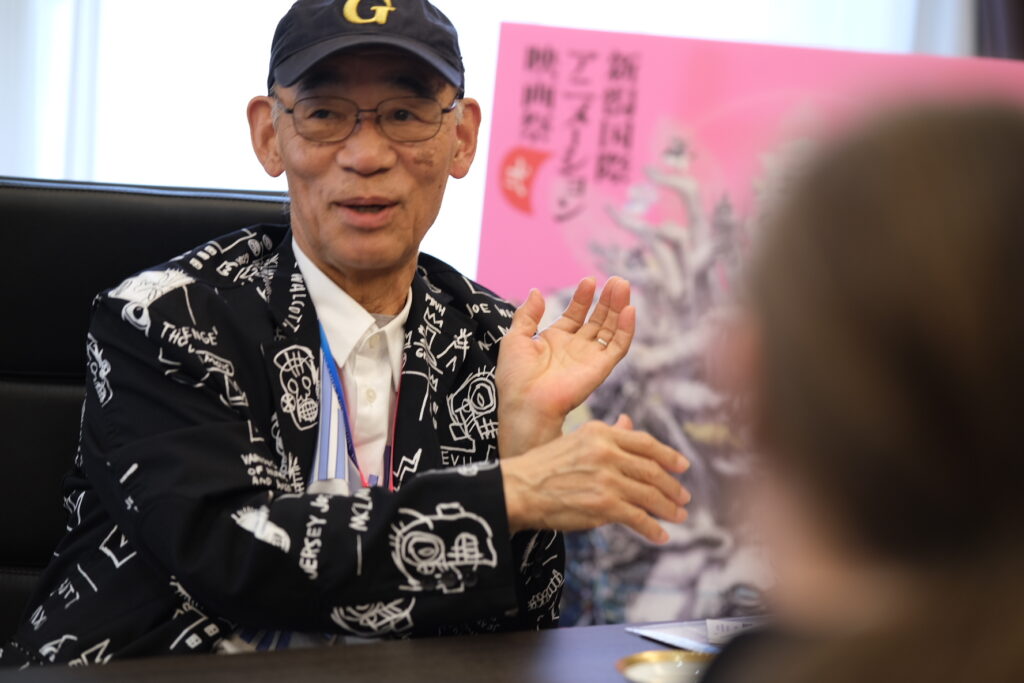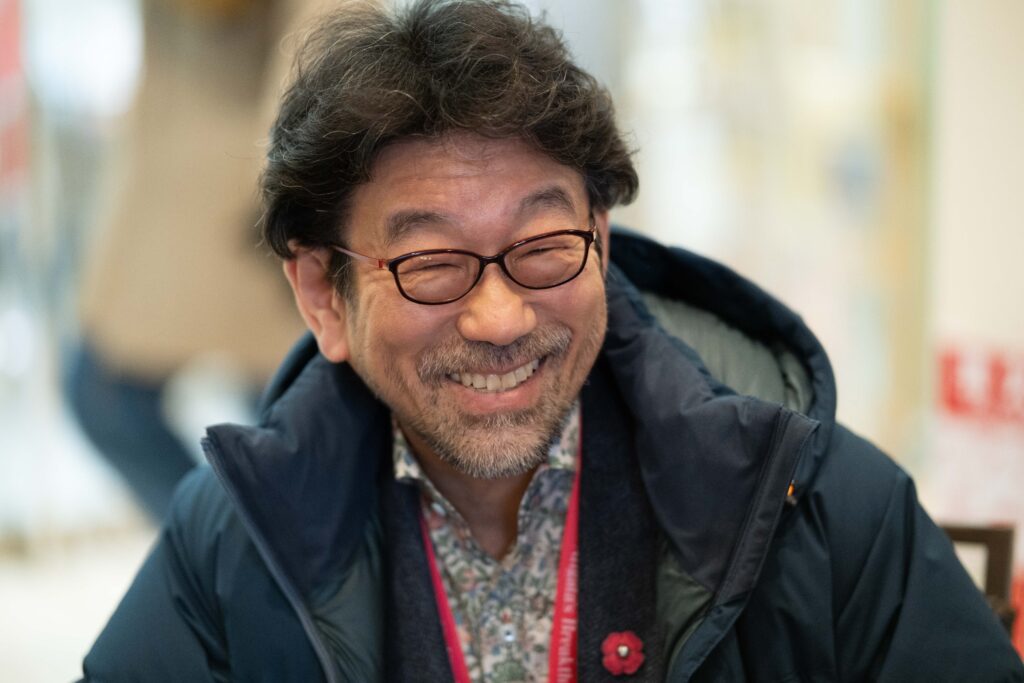Shingo Natsume is one of the greatest anime directors of today’s generation. Having moved from the video game to the animation industry in the early 2000s, he became associated with Studio Madhouse following his first collaboration with Masaaki Yuasa on The Tatami Galaxy in 2010. Since then, he has directed some of the most impressive anime TV shows of the 2010s: Space Dandy (2013, for Studio Bones), One Punch Man (2015), and ACCA: 13-Territory Inspection Department (2017). His latest series, the meditative and experimental Sonny Boy, was nominated at the Annecy International Animation Festival in the TV works category. It was on this occasion that a meeting with the press was organized in Annecy featuring Mr. Natsume, Sonny Boy‘s art director Mari Fujino, and some of the production staff from the series.
Like our content? Feel free to support us on Ko-Fi!
“I could make the kind of work that you don’t see every day.”
Mr. Natsume, you’re in the official competition for TV works at the Annecy festival. How does it feel?
Shingo Natsume: I was very surprised to be nominated. As a director, it’s a very strange feeling; I’m wondering how it will go.
Sonny Boy doesn’t have an opening. Why is that?
Shingo Natsume: There are mainly two reasons. I’ve been thinking for some time that an opening isn’t that necessary, and when I asked the producers, they said there was no problem if we didn’t include one. The other reason is that the story was very dense, and we didn’t have enough runtime to fit all the plot elements in, so we used all the additional time we could get from removing the opening.
You’ve said that Sonny Boy is a “selfish” work; was this made possible by your relationship with producer Mukaichi?
Shingo Natsume: Indeed, the producer gave me a lot of creative freedom so that I could make the kind of work that you don’t see every day, the somewhat egocentric kind. So I thank him for that. [Smiles and turns to Mr. Mukaichi standing behind him.]
Mr. Natsume, you’ve mentioned that you included many things you like in Sonny Boy. Personally, I strongly felt Hideaki Anno’s influence, particularly on the episodes you storyboarded yourself. If that’s the case, we’d like to know more about your relationship to Anno’s work.
Shingo Natsume: I appreciate Mr. Anno immensely. I watched Evangelion at 15, that is Shinji’s age, and it left a strong impression. It was new, and in terms of images, it was one tier above. Until then, there had been a lot of tropes in anime, and Mr. Anno completely destroyed them. That’s what influenced me, and I’m using it as a reference for Sonny Boy.
You mentioned that Sonny Boy is your first original work. Today, original series are scarce, so we’d like to hear more about the difficulties arising from these kinds of projects.
Shingo Natsume: Of course, on original work, you have to do everything from the ground up, and so there are a lot of things to create; it’s very time-consuming… Since it’s original, we’re trying to make something different from already existing novels or manga. I’ve tried to do something usual, but not ordinary. It was really hard to strike that balance. Moreover, since I had to do everything by myself, I often took the wrong direction; it was very stressful. You mentioned Mr. Anno just now, and I feel like I can finally understand him.
On Sonny Boy, you chose not to include monologues and never make the viewer hear the characters’ thoughts. As a result, most of the information is conveyed by the visuals. Was that a particular challenge during the storyboarding and animation processes?
Shingo Natsume: As you said, there are a lot of internal monologues in Japanese animation. It’s something I don’t like, so I decided to take them out.
If the viewer wants to understand the characters’ motivations, I wanted that they should only pay attention to what’s going on on the screen, the way characters act, but also the way their actions and words can contradict each other. I took a lot of care to insert such contradictions in order to develop the complexity of characters, hidden meanings, and so on… Obviously, for that reason, I had to write the storyboards with a lot of subtlety and sensibility.
To remain on this topic, storyboarding is usually an essential moment in the production pipeline. Did the complexity of Sonny Boy’s writing and worldbuilding encourage you to do things differently?
Shingo Natsume: It’s a very complicated question…. When I was doing the storyboards, information control was very important. I was always asking myself what I should show or not, in a way that the viewer should remain free to imagine what each thing could mean. I think it’s a way to make things more interesting and complex for the viewer. That’s why you should never show too much.
“Mr. Eguchi creates a sense of nostalgia while remaining very fresh.”
Mr. Natsume, Ms. Fujino, Sonny Boy isn’t your first collaboration. We’d like to know what you appreciate about working together and what you think makes the other special?
Shingo Natsume: We first worked together on Acca, and I really liked Studio Pablo’s background art. Ms. Fujino is very talented in the way she uses the color palette, which is why I definitely wanted to work with her on Sonny Boy. The collaboration with Studio Pablo was perfect: we have a great mutual understanding, the work was easy, and it was very pleasant.
Mari Fujino: Acca was very simple and pleasant. What’s unique and pleasant with Mr. Natsume is that he gives us a lot of freedom: during meetings, he would often ask me what I thought about something, unlike many other directors. So it’s something I strongly appreciated.
Sonny Boy’s atmosphere is quite nostalgic. Is that why you wanted to collaborate with Mr. Hisashi Eguchi for the character design?
Shingo Natsume: I had a lot of creative freedom, especially since it was my first original work. I could therefore go all the way and put in everything I like, including the kind of works that I appreciated when I was young and that left a strong impression on me, such as those by Mr. Eguchi.
Ms. Fujino, did Mr. Eguchi’s work change your approach to the background art?
Mari Fujino: Since childhood, I’ve always read things drawn by Mr. Eguchi, so I was very happy to work with him. His characters are very simple, without any unnecessary details, and have been a big inspiration to create the backgrounds.
It’s been 20 years that Mr. Eguchi hasn’t worked on an animated work, was his return to animation difficult or challenging?
Shingo Natsume: Well, Mr. Eguchi has kept writing manga during that time, but he’s also doing illustration, and in Japan, you still see his drawings pretty much everywhere. For that reason, he’s quite modern. It’s somewhat hard to explain, but Mr. Eguchi creates a sense of nostalgia while remaining very fresh, which is very good.
The color palette on Sony Boy is very bright, with strong contrasts, and is reminiscent of the first computer screens that just had 32 or 64 colors. Could you tell us why you made that choice when it’s so easy to have thousands of nuances today, and if that posed a challenge to Ms. Fujino.
Shingo Natsume: I like simplicity; it’s something I care about a lot. Another important thing for me is contrasts: when I’m drawing, and I use blue, it has to be solid blue. When I’m using grey, it has to be solid grey… I believe that’s a way for me to push the viewers to focus on the story.
Mari Fujino: That simplicity wasn’t a difficulty at all: in fact, I could now focus on the beauty of forms, for example, that of trees, and to put care into the outline of each object. It’s something I liked a lot, so I want to emphasize: that it wasn’t a problem in any way.
Shingo Natsume: Are there really so few colors in the backgrounds?
Kentaro Akiyama [TN: Head representative of Studio Pablo]: There are no gradients.
Mari Fujino: Yes, very few color gradations.
Kentaro Akiyama: It’s in that sense that you could say there aren’t many colors. The contrasts are very strong.
Isn’t that related to Eguchi’s style?
Shingo Natsume: Unconsciously, probably. My mind is steeped in his drawings.
Mari Fujino: It’s the same for me.
Many of your works have impressive technical aspects, such as One Punch Man, Space Dandy or Sonny Boy. How do you manage to gather so many talented animators around you?
Shingo Natsume: First, there’s luck! I also got a lot of help from a producer, Mr. Fukushi, who brought a lot of great animators to me. And, of course, I’ve been an animator myself, so I can always ask the colleagues I worked with to help me on the things I direct now.
“Every teenager has doubts about their life.”
Sonny Boy feels very timeless. There aren’t many ways to see when everything happens. However, it’s about today’s youth, with topics such as social media, technology, etc. You’re in your 40s already, so how did you try to reproduce the mindset of today’s teens?
Shingo Natsume: Sonny Boy’s characters are 15. For that reason, I read many books and followed the news to learn more about young people. There’s a difference between someone who’s lived for 15 years and someone who’s lived for 40; our way of thinking isn’t the same. Moreover, being 15 at one point isn’t the same as being 15 at another time. I really thought about what I thought when I was 15 and how I felt, and I tried to remember what I talked about with my friends… It’s from all these elements that the characters emerged.
Ms. Fujino, was this specific atmosphere and the lack of chronological or spatial landmarks challenging?
Mari Fujino: Maybe my answer will be the same as Mr. Natsume’s… Every teenager has doubts about their life. I believe that’s something universal. So that’s something I really focused on when doing the backgrounds.
Mr. Natsume, you are directing the next entry in the Tatami Galaxy series, Tatami Time Machine Blues. What’s your relationship with Mr. Yuasa, the director of the original series?
Shingo Natsume: Mr. Yuasa is a wonderful person, and it was under him that I directed a TV show episode for the first time. I could even do location hunting with him at the time. After his latest film, Inu-Oh, I had a drink with him. I’m sorry about saying this, and I hope no one takes it badly, but Mr. Yuasa tends to point out the defaults and mistakes in people, saying things like “in school, they were like this or like that,” and it can be unsettling. And so it’s through him that I learned that I was “insolent.”
How did you end up as director of the following series?
Shingo Natsume: [Hesitates, turns to Mukaichi] It’s a somewhat sensitive topic… I know very well Ms. Enyoung Choi, the president of Science Saru, the studio where Mr. Yuasa used to work. One day, she sent me the scenario, which was wonderful, so I was enthusiastic about directing it. I believe Ms. Enyoung trusted me to direct it so that it would keep the spirit of Mr. Yuasa’s work.
Interview conducted by Dimitri Seraki, Matteo Watzky, Ludovic Joyet (Full Frontal) Mathieu Pinon and Anton Guzman (Coyote Mag), Tadashi Sudo (Animation Business), and Pascal Voglimacci (Journal du Japon)
Interpreter: Vincent Marcantognini
Translation by Ludovic Joyet and Matteo Watzky.
Special thanks to Jonathan Guetta (JM Production), Marion Cochet-Grasset (Wizard Communication), and Olivier Fallaix (Crunchyroll France).
Like our content? Feel free to support us on Ko-Fi!
You might also be interested in
Oshi no Ko & (Mis)Communication – Short Interview with Aka Akasaka and Mengo Yokoyari
The Oshi no Ko manga, which recently ended its publication, was created through the association of two successful authors, Aka Akasaka, mangaka of the hit love comedy Kaguya-sama: Love Is War, and Mengo Yokoyari, creator of Scum's Wish. During their visit at the...
Ideon is the Ego’s death – Yoshiyuki Tomino Interview [Niigata International Animation Film Festival 2024]
Yoshiyuki Tomino is, without any doubt, one of the most famous and important directors in anime history. Not just one of the creators of Gundam, he is an incredibly prolific creator whose work impacted both robot anime and science-fiction in general. It was during...
“Film festivals are about meetings and discoveries” – Interview with Tarô Maki, Niigata International Animation Film Festival General Producer
As the representative director of planning company Genco, Tarô Maki has been a major figure in the Japanese animation industry for decades. This is due in no part to his role as a producer on some of anime’s greatest successes, notably in the theaters, with films...





Thank you so much for doing this interview!! Great read 🙂